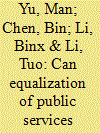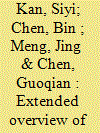|
|
|
Sort Order |
|
|
|
Items / Page
|
|
|
|
|
|
|
| Srl | Item |
| 1 |
ID:
159047


|
|
|
|
|
| Summary/Abstract |
Regional disparities that challenge the economy and public administration must be confronted by the governments and public in developing countries. As the extensive mode of economic growth has caused many problems in China, it is necessary to find other ways to promote the development of poor areas to narrow regional disparities in the country. This paper measures the equalization of public services and residents' living standards in China, based on a provincial panel data for the period 2001–2013, to analyze the impact of the equalization of public services on China's regional disparities. The empirical results, based on spatial econometrics models, show that the equalization of all types of public services can promote the regional equality of incomes and consumptions. There is also evidence suggesting that the regional disparities are affected by other economic and social factors.
|
|
|
|
|
|
|
|
|
|
|
|
|
|
|
|
| 2 |
ID:
125447


|
|
|
|
|
| Publication |
2013.
|
| Summary/Abstract |
The evaluation of ecosystem health in urban clusters will help establish effective management that promotes sustainable regional development. To standardize the application of emergy synthesis and set pair analysis (EM-SPA) in ecosystem health assessment, a procedure for using EM-SPA models was established in this paper by combining the ability of emergy synthesis to reflect health status from a biophysical perspective with the ability of set pair analysis to describe extensive relationships among different variables. Based on the EM-SPA model, the relative health levels of selected urban clusters and their related ecosystem health patterns were characterized. The health states of three typical Chinese urban clusters - Jing-Jin-Tang, Yangtze River Delta, and Pearl River Delta - were investigated using the model. The results showed that the health status of the Pearl River Delta was relatively good; the health for the Yangtze River Delta was poor. As for the specific health characteristics, the Pearl River Delta and Yangtze River Delta urban clusters were relatively strong in Vigor, Resilience, and Urban ecosystem service function maintenance, while the Jing-Jin-Tang was relatively strong in organizational structure and environmental impact. Guidelines for managing these different urban clusters were put forward based on the analysis of the results of this study.
|
|
|
|
|
|
|
|
|
|
|
|
|
|
|
|
| 3 |
ID:
171357


|
|
|
|
|
| Summary/Abstract |
As an extension of our previous study on natural gas use in world economy (Kan et al., Energy Policy 124 (2019) 215–225), this paper explores policy implications based on a time series analysis uncovering the evolution of natural gas use embodied in global supply chains during 2000-2011. Due to increasing gas supply from gas-rich regions to gas-scarce regions and outsourcing of energy-intensive industries, trade imbalance of embodied natural gas is intensifying globally, corresponding to strengthening gas resource relocation and environmental stress shift. Regarding trade patterns, EU and Russia remain the leading (net) importer and exporter of embodied gas, respectively. And global trade relations are diversifying over time, with more suppliers and recipients joining the international trade. Based on the New Policies Scenario provided by IEA, a long term forecast of embodied gas use illustrates need to prepare for a world with changing energy mix, with respect to growing availability of low-cost natural gas and robust demand growth coming from emerging economies, especially China, who is struggling to fight against air pollution through coal-to-gas switch. Potential room to expand natural gas utilization is also targeted, and the expansion requires coordination of all the agents in global supply chains.
|
|
|
|
|
|
|
|
|
|
|
|
|
|
|
|
| 4 |
ID:
125767


|
|
|
|
|
| Publication |
2013.
|
| Summary/Abstract |
Biogas plant construction has been boosted in rural China not only due to the immediate merit from biogas production but also the succeeding benefit from by-product utilization in agro-industry, both of which are significant strategies to address energy shortage and global warming issues. However, little work has been done to evaluate the coupling of biogas projects to traditional agrosystems from a life-cycle perspective, which is most important in process and system optimization in different senses. By taking persimmon cultivation and processing with supports from a household biogas plant as a case study, this study conducts a life cycle assessment of coupling biogas production to agro-industry in terms of energy, environmental and economic performance. The results suggest that each production stage following the biogas/digestate utilization chain (biogas operation-persimmon cultivation-product processing) is beneficial across all three aspects. However, a tradeoff only exists in utilizing digestate as top-dressing and employing biogas utilization as engine fuel, while biogas application in fresh-keeping and digestate reuse as base fertilizer fails to increase either energy production or greenhouse gas mitigation. The coupled system can be hopefully optimized through increasing fermentation efficiency and joint operation of biogas digesters.
|
|
|
|
|
|
|
|
|
|
|
|
|
|
|
|
|
|
|
|
|